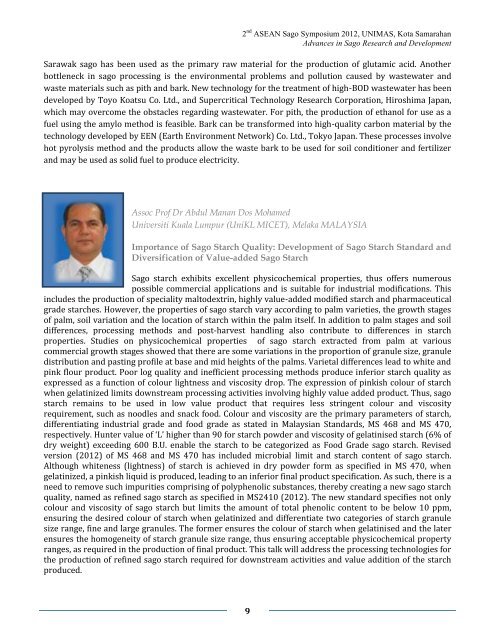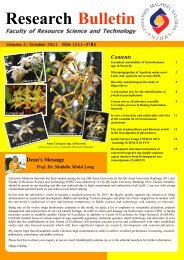2nd ASEAN Sago Symposium 2012, UNIMAS, Kota Samarahan ...
2nd ASEAN Sago Symposium 2012, UNIMAS, Kota Samarahan ...
2nd ASEAN Sago Symposium 2012, UNIMAS, Kota Samarahan ...
Create successful ePaper yourself
Turn your PDF publications into a flip-book with our unique Google optimized e-Paper software.
2 nd <strong>ASEAN</strong> <strong>Sago</strong> <strong>Symposium</strong> <strong>2012</strong>, <strong>UNIMAS</strong>, <strong>Kota</strong> <strong>Samarahan</strong><br />
Advances in <strong>Sago</strong> Research and Development<br />
Sarawak sago has been used as the primary raw material for the production of glutamic acid. Another<br />
bottleneck in sago processing is the environmental problems and pollution caused by wastewater and<br />
waste materials such as pith and bark. New technology for the treatment of high-BOD wastewater has been<br />
developed by Toyo Koatsu Co. Ltd., and Supercritical Technology Research Corporation, Hiroshima Japan,<br />
which may overcome the obstacles regarding wastewater. For pith, the production of ethanol for use as a<br />
fuel using the amylo method is feasible. Bark can be transformed into high-quality carbon material by the<br />
technology developed by EEN (Earth Environment Network) Co. Ltd., Tokyo Japan. These processes involve<br />
hot pyrolysis method and the products allow the waste bark to be used for soil conditioner and fertilizer<br />
and may be used as solid fuel to produce electricity.<br />
Assoc Prof Dr Abdul Manan Dos Mohamed<br />
Universiti Kuala Lumpur (UniKL MICET), Melaka MALAYSIA<br />
Importance of <strong>Sago</strong> Starch Quality: Development of <strong>Sago</strong> Starch Standard and<br />
Diversification of Value-added <strong>Sago</strong> Starch<br />
<strong>Sago</strong> starch exhibits excellent physicochemical properties, thus offers numerous<br />
possible commercial applications and is suitable for industrial modifications. This<br />
includes the production of speciality maltodextrin, highly value-added modified starch and pharmaceutical<br />
grade starches. However, the properties of sago starch vary according to palm varieties, the growth stages<br />
of palm, soil variation and the location of starch within the palm itself. In addition to palm stages and soil<br />
differences, processing methods and post-harvest handling also contribute to differences in starch<br />
properties. Studies on physicochemical properties of sago starch extracted from palm at various<br />
commercial growth stages showed that there are some variations in the proportion of granule size, granule<br />
distribution and pasting profile at base and mid heights of the palms. Varietal differences lead to white and<br />
pink flour product. Poor log quality and inefficient processing methods produce inferior starch quality as<br />
expressed as a function of colour lightness and viscosity drop. The expression of pinkish colour of starch<br />
when gelatinized limits downstream processing activities involving highly value added product. Thus, sago<br />
starch remains to be used in low value product that requires less stringent colour and viscosity<br />
requirement, such as noodles and snack food. Colour and viscosity are the primary parameters of starch,<br />
differentiating industrial grade and food grade as stated in Malaysian Standards, MS 468 and MS 470,<br />
respectively. Hunter value of ‘L’ higher than 90 for starch powder and viscosity of gelatinised starch (6% of<br />
dry weight) exceeding 600 B.U. enable the starch to be categorized as Food Grade sago starch. Revised<br />
version (<strong>2012</strong>) of MS 468 and MS 470 has included microbial limit and starch content of sago starch.<br />
Although whiteness (lightness) of starch is achieved in dry powder form as specified in MS 470, when<br />
gelatinized, a pinkish liquid is produced, leading to an inferior final product specification. As such, there is a<br />
need to remove such impurities comprising of polyphenolic substances, thereby creating a new sago starch<br />
quality, named as refined sago starch as specified in MS2410 (<strong>2012</strong>). The new standard specifies not only<br />
colour and viscosity of sago starch but limits the amount of total phenolic content to be below 10 ppm,<br />
ensuring the desired colour of starch when gelatinized and differentiate two categories of starch granule<br />
size range, fine and large granules. The former ensures the colour of starch when gelatinised and the later<br />
ensures the homogeneity of starch granule size range, thus ensuring acceptable physicochemical property<br />
ranges, as required in the production of final product. This talk will address the processing technologies for<br />
the production of refined sago starch required for downstream activities and value addition of the starch<br />
produced.<br />
9



